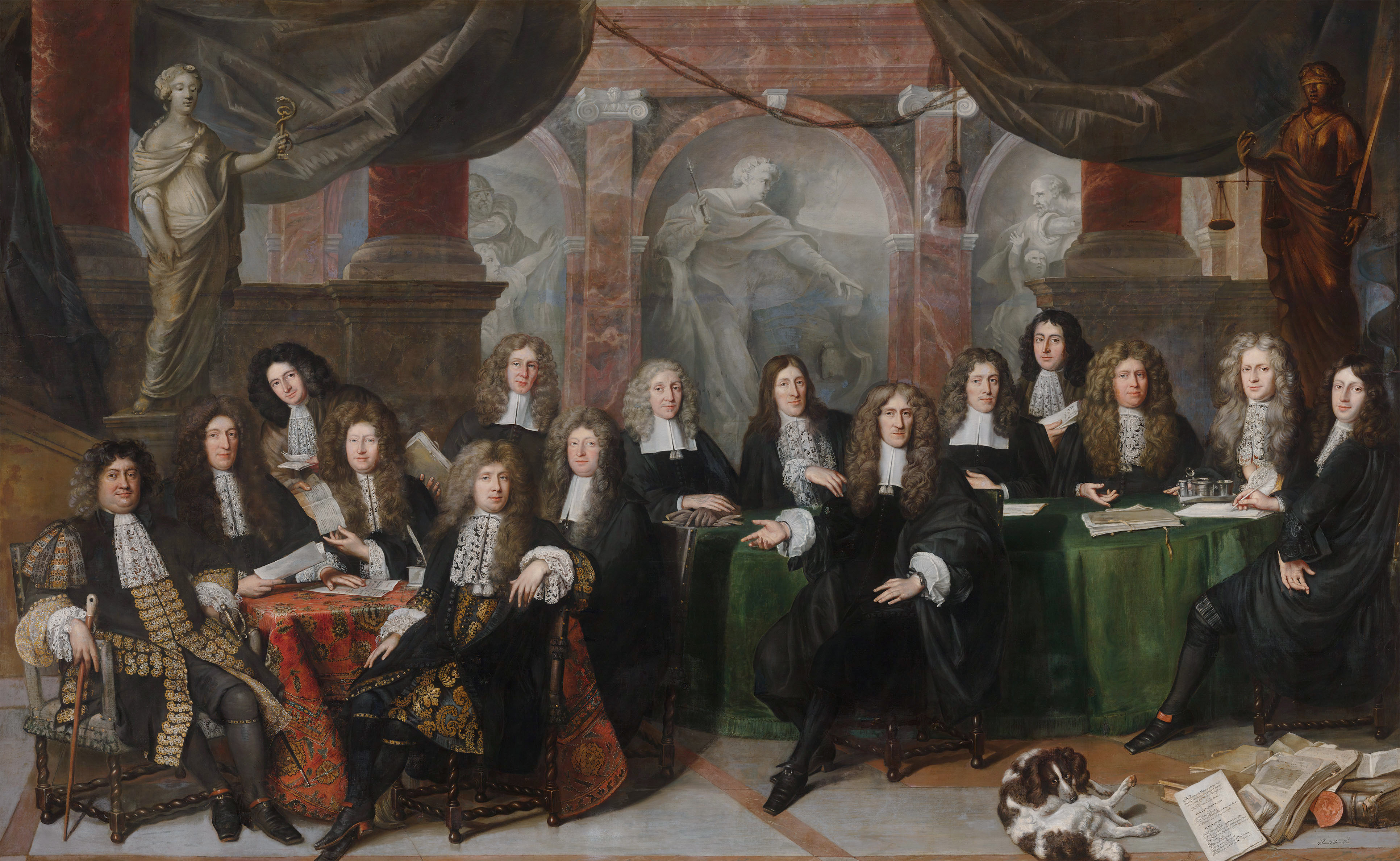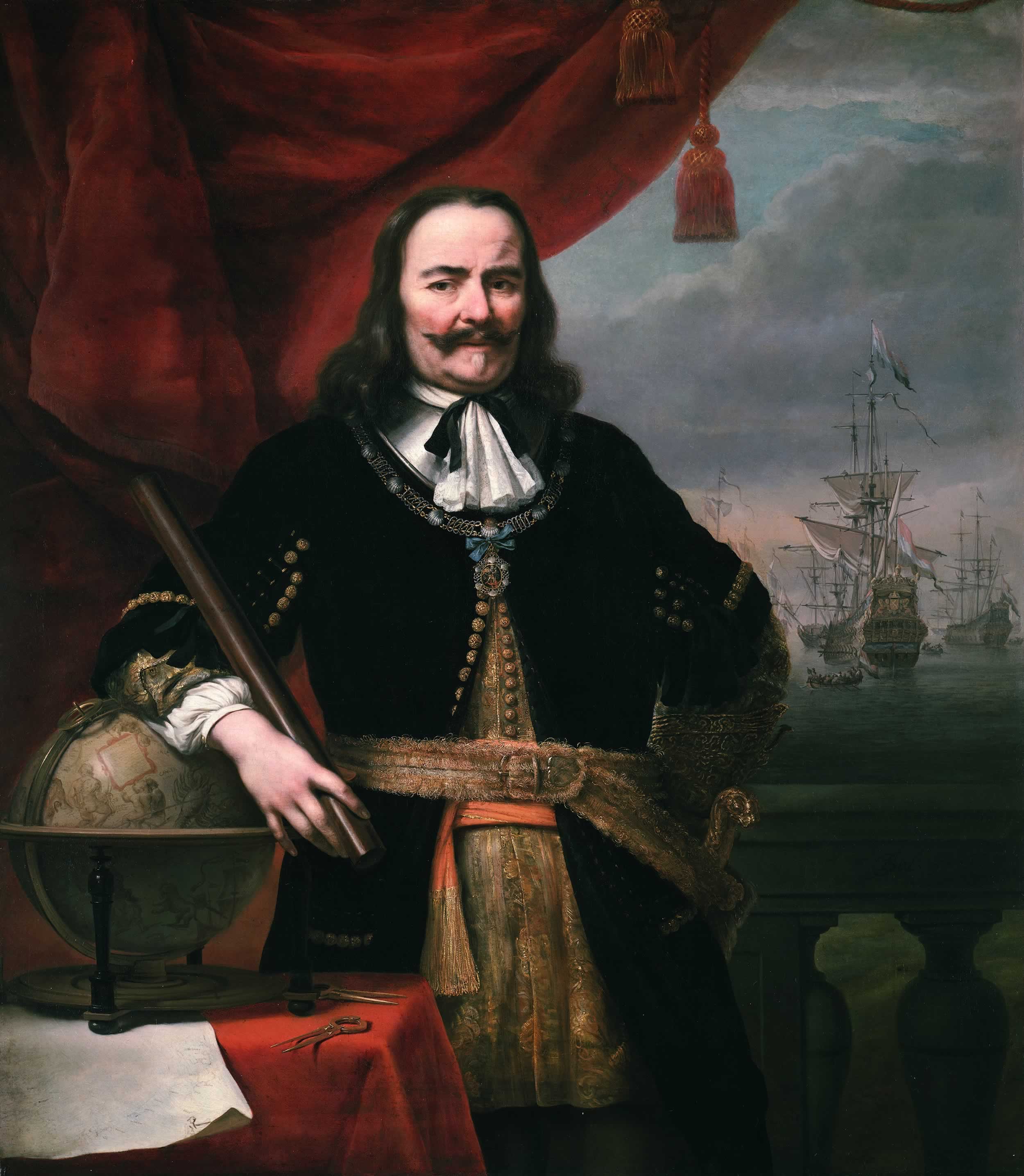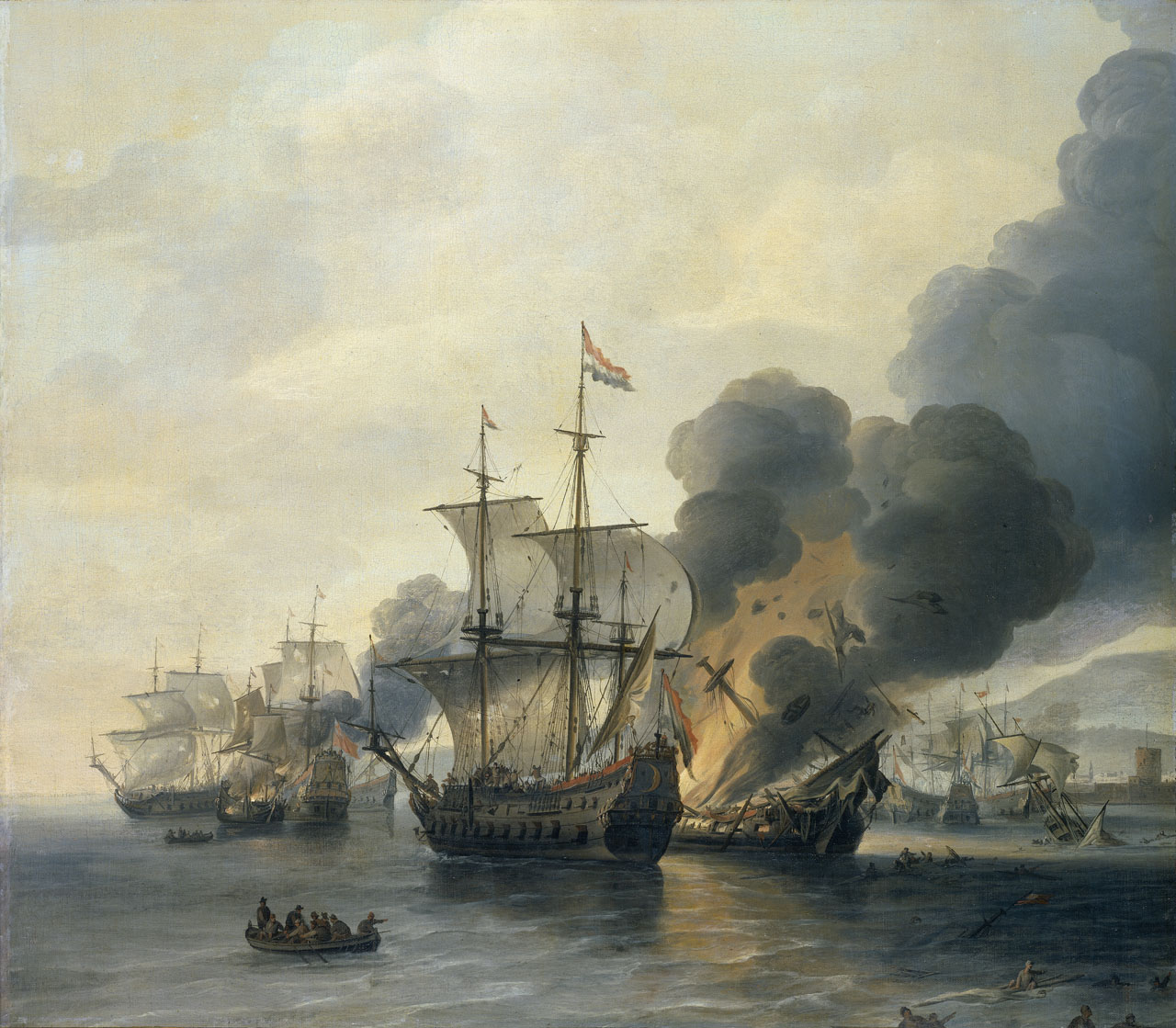|
Willem Joseph Van Ghent
Willem Joseph baron van Ghent tot Drakenburgh (14 May 1626 – 7 June 1672) was a 17th-century Dutch admiral. His surname is also sometimes rendered Gendt or Gent. Early career Van Ghent was baptised on 14 May 1626, in the church of Winssen. It is assumed he was born the same day. In 1642, he became provost of Elst, as a sinecure. Of noble birth, he made a career in the army from 1645 onwards; he started in the regiment of the Count of Hoorne; in 1648, he was promoted to the rank of captain, serving in said regiment. He first became connected to the navy when during the Northern Wars against Sweden in 1659, he executed a landing on the Danish island of Funen under command of Vice-Admiral Michiel de Ruyter. At that time, Van Gendt was an unsalaried major, commanding a regiment of Walloons. During this campaign, there was a large emphasis on and development of amphibious operations, involving Dutch naval officers like the later Rear-Admiral Frederick Stachouwer and Vice ... [...More Info...] [...Related Items...] OR: [Wikipedia] [Google] [Baidu] |
Jan De Baen
Jan de Baen (20 February 1633 – 1702) was a Dutch portrait painter who lived during the Dutch Golden Age. He was a pupil of the painter Jacob Adriaensz Backer in Amsterdam from 1645 to 1648. He worked for Charles II of England in his Dutch exile, and from 1660 until his death he lived and worked in The Hague. His portraits were popular in his day, and he painted the most distinguished people of his time. Biography Jan de Baen was born on 20 February 1633 in Haarlem, Holland, Dutch Republic. After his parents died, when he was a child, he lived with his uncle Hinderk Pyman (or Piemans) in Emden. Jan de Baen received his first painting lessons from his uncle, who was a painter himself. From 1645 to 1648 he lived in Amsterdam, where he was the pupil of painter Jacob Adriaensz Backer. After completing his training, he worked for the exiled court of Charles II of England, but upon the English Restoration of 1660 did not follow his patron, but moved to The Hague, where he worked as ... [...More Info...] [...Related Items...] OR: [Wikipedia] [Google] [Baidu] |
Volckert Schram
Volckert Adriaanszoon Schram ( Enkhuizen, c. 1620 – 7 June 1673) was a 17th-century Dutch admiral Admiral is one of the highest ranks in some navies. In the Commonwealth nations and the United States, a "full" admiral is equivalent to a "full" general in the army or the air force, and is above vice admiral and below admiral of the fleet .... His name was also spelled Volkert or Volkhard. 1620 births 1673 deaths Dutch naval personnel of the Anglo-Dutch Wars People from Enkhuizen {{Netherlands-mil-bio-stub ... [...More Info...] [...Related Items...] OR: [Wikipedia] [Google] [Baidu] |
Swell (ocean)
A swell, also sometimes referred to as ground swell, in the context of an ocean, sea or lake, is a series of mechanical waves that propagate along the interface between water and air under the predominating influence of gravity, and thus are often referred to as surface gravity waves. These surface gravity waves have their origin as wind waves, but are the consequence of dispersion of wind waves from distant weather systems, where wind blows for a duration of time over a fetch of water, and these waves move out from the source area at speeds that are a function of wave period and length. More generally, a swell consists of wind-generated waves that are not greatly affected by the local wind at that time. Swell waves often have a relatively long wavelength, as short wavelength waves carry less energy and dissipate faster, but this varies due to the size, strength, and duration of the weather system responsible for the swell and the size of the water body, and varies from event to ... [...More Info...] [...Related Items...] OR: [Wikipedia] [Google] [Baidu] |
Four Days' Battle
The Four Days' Battle, also known as the Four Days' Fight in some English sources and as Vierdaagse Zeeslag in Dutch, was a naval battle of the Second Anglo-Dutch War. Fought from 1 June to 4 June 1666 in the Julian or Old Style calendar that was then used in England, in the southern North Sea, it began off the Flemish coast and ended near the English coast. It remains one of the longest naval engagements in history. Dutch accounts referred to its dates as 11 June to 14 June 1666 by using the New Style calendar. The Dutch inflicted significant damage on the English fleet, which lost ten ships in total, with over 1,000 men killed, including two vice-admirals, Sir Christopher Myngs and Sir William Berkeley, and almost 2,000 English were taken prisoner including a third vice-admiral, George Ayscue. Dutch losses were four ships destroyed by fire and over 1,550 men killed, including Lieutenant Admiral Cornelis Evertsen, Vice Admiral Abraham van der Hulst and Rear Admiral Frederik ... [...More Info...] [...Related Items...] OR: [Wikipedia] [Google] [Baidu] |
François Palm
François () is a French masculine given name and surname, equivalent to the English name Francis. People with the given name * Francis I of France, King of France (), known as "the Father and Restorer of Letters" * Francis II of France, King of France and King consort of Scots (), known as the husband of Mary Stuart, Queen of Scots * François Amoudruz (1926–2020), French resistance fighter * François-Marie Arouet (better known as Voltaire; 1694–1778), French Enlightenment writer, historian, and philosopher *François Aubry (other), several people *François Baby (other), several people * François Beauchemin (born 1980), Canadian ice hockey player for the Anaheim Duck *François Blanc (1806–1877), French entrepreneur and operator of casinos *François Boucher (other), several people *François Caron (other), several people * François Cevert (1944–1973), French racing driver * François Chau (born 1959), Cambodian American actor * Fr ... [...More Info...] [...Related Items...] OR: [Wikipedia] [Google] [Baidu] |
Cornelis Tromp
Cornelis Maartenszoon Tromp, ''Count of Sølvesborg'' (3 September 1629 – 29 May 1691) was a Dutch naval officer who served as lieutenant-admiral general in the Dutch Navy, and briefly as a general admiral in the Royal Danish Navy. Tromp fought in the Anglo-Dutch Wars and the Scanian War. His father was Lieutenant Admiral Maarten Tromp. Biography Early life Cornelis Maartenszoon Tromp was born on 9 September 1629, in Rotterdam, in the historically dominant county of Holland. He was the second son of Maarten Tromp and Dina Cornelisdochter de Haas. His name Maartenszoon, sometimes abbreviated to Maartensz, is a patronymic. He had two full brothers, Harper and Johan.Tromp, Cornelis in ''Nieuw Nederlandsch biografisch woordenboek. Deel 5''. Retrieved 5 May 2009. In 1633, when he was only four ye ... [...More Info...] [...Related Items...] OR: [Wikipedia] [Google] [Baidu] |
Captain At Sea
Captain is the name most often given in English-speaking navies to the rank corresponding to command of the largest ships. The rank is equal to the army rank of colonel and air force rank of group captain. Equivalent ranks worldwide include ship-of-the-line captain (e.g. France, Argentina, Spain), captain of sea and war (e.g. Brazil, Portugal), captain at sea (e.g. Germany, Netherlands) and " captain of the first rank" (Russia). The NATO rank code is OF-5, although the United States of America uses the code O-6 for the equivalent rank (as it does for all OF-5 ranks). Four of the uniformed services of the United States — the United States Navy, United States Coast Guard, United States Public Health Service Commissioned Corps, and National Oceanic and Atmospheric Administration Commissioned Officer Corps — use the rank. Etiquette Any naval officer who commands a ship is addressed by naval custom as "captain" while aboard in command, regardless of their actual rank, even ... [...More Info...] [...Related Items...] OR: [Wikipedia] [Google] [Baidu] |
Chatham Dockyard
Chatham Dockyard was a Royal Navy Dockyard located on the River Medway in Kent. Established in Chatham in the mid-16th century, the dockyard subsequently expanded into neighbouring Gillingham (at its most extensive, in the early 20th century, two-thirds of the dockyard lay in Gillingham, one-third in Chatham). It came into existence at the time when, following the Reformation, relations with the Catholic countries of Europe had worsened, leading to a requirement for additional defences. Over 414 years Chatham Royal Dockyard provided more than 500 ships for the Royal Navy, and was at the forefront of shipbuilding, industrial and architectural technology. At its height, it employed over 10,000 skilled artisans and covered . Chatham dockyard closed in 1984, and of the Georgian dockyard is now managed as the Chatham Historic Dockyard visitor attraction by the Chatham Historic Dockyard Trust. Overview Joseph Farington (1747-1821) was commissioned by the Navy Board to paint a pa ... [...More Info...] [...Related Items...] OR: [Wikipedia] [Google] [Baidu] |
Johan De Witt
Johan de Witt (; 24 September 1625 – 20 August 1672), ''lord of Zuid- en Noord-Linschoten, Snelrewaard, Hekendorp en IJsselvere'', was a Dutch statesman and a major political figure in the Dutch Republic in the mid-17th century, the First Stadtholderless Period, when its flourishing sea trade in a period of globalization made the republic a leading European trading and seafaring power – now commonly referred to as the Dutch Golden Age. De Witt controlled the Dutch political system from around 1650 until shortly before his murder and cannibalisation by a pro-Orangist mob in 1672. As a leading republican of the Dutch States Party, de Witt opposed the House of Orange-Nassau and the Orangists and preferred a shift of power from the central government to the regenten. However, his neglect of the Dutch army (as the regents focused only on merchant vessels, thinking they could avoid war) proved disastrous when the Dutch Republic suffered numerous early defeats in th ... [...More Info...] [...Related Items...] OR: [Wikipedia] [Google] [Baidu] |
Dutch Republic
The United Provinces of the Netherlands, also known as the (Seven) United Provinces, officially as the Republic of the Seven United Netherlands (Dutch: ''Republiek der Zeven Verenigde Nederlanden''), and commonly referred to in historiography as the Dutch Republic, was a federal republic that existed from 1579, during the Dutch Revolt, to 1795 (the Batavian Revolution). It was a predecessor state of the Netherlands and the first fully independent Dutch nation state. The republic was established after seven Dutch provinces in the Spanish Netherlands revolted against rule by Spain. The provinces formed a mutual alliance against Spain in 1579 (the Union of Utrecht) and declared their independence in 1581 (the Act of Abjuration). It comprised Groningen, Frisia, Overijssel, Guelders, Utrecht, Holland and Zeeland. Although the state was small and contained only around 1.5 million inhabitants, it controlled a worldwide network of seafaring trade routes. Through its tradin ... [...More Info...] [...Related Items...] OR: [Wikipedia] [Google] [Baidu] |
Battle Of Vågen
The Battle of Vågen was a naval battle between a Netherlands, Dutch merchant and treasure fleet; and an England, English flotilla of warships in August 1665 as part of the Second Anglo-Dutch War. The battle took place in Vågen, Bergen, Vågen (meaning "the bay, wikt:voe, voe" in Norwegian language, Norwegian), the main port area of neutral Bergen, Norway. Due to a delay in orders, the Norwegian commanders took the side of the Dutch, contrary to the secret intentions of the King of Norway and Denmark. The battle ended with the retreat of the English fleet, which was much damaged but had lost no ships. The treasure fleet was relieved by the Dutch home fleet 17 days later. Arrival in Bergen The Dutch merchant fleet had about 60 vessels. Ten of them were Dutch East India Company, Dutch East India Company (VOC) vessels, commanded by Commodore Pieter de Bitter, which were returning from the East Indies. Twice each year, the Dutch East India Company sent a Return Fleet back to the Net ... [...More Info...] [...Related Items...] OR: [Wikipedia] [Google] [Baidu] |
_-_The_Destroying_of_Six_Barbary_Ships_near_Cape_Spartel_-_RCIN_405224_-_Royal_Collection.jpg)







